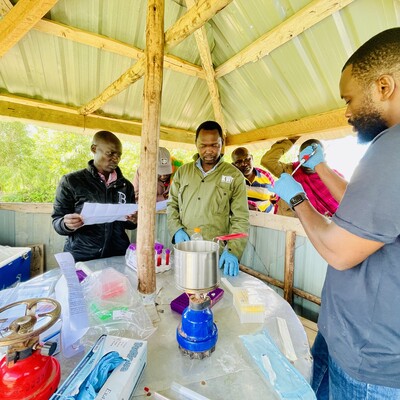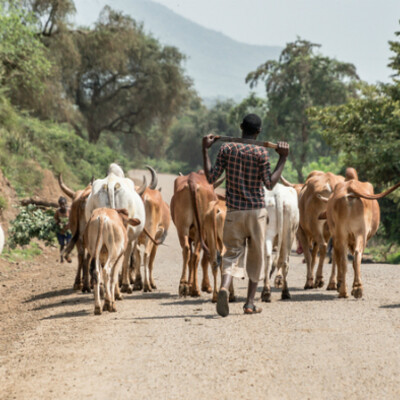
Making livestock vaccination campaigns work for farmers in East Africa
A gender-inclusive approach to community livestock vaccination can help address the different barriers faced by men and women farmers and may increase the uptake of livestock vaccines
Scientists at the International Livestock Research Institute (ILRI) recently published a study on the uptake of the Rift Valley fever vaccine in Kenya and Uganda, incorporating gender in their analysis to better understand the different barriers that men and women farmers face in adopting and using livestock vaccines.
The barriers include the cost of vaccines, long distances to vaccination points, lack of information on vaccination campaigns and decision-making processes at the household level. Understanding these barriers can help veterinary workers design more effective community livestock vaccination programs of benefit to both men and women farmers.
‘Conducting gender analysis on livestock vaccine interventions can enable implementers to identify generic and gender-specific needs of their target beneficiaries’, says Edna Mutua, the lead author of the study and gender consultant at ILRI.
‘This will allow the use of the findings to inform the design and delivery of vaccination interventions to increase efficiency and uptake’, she adds.
Rift Valley fever is a viral, mosquito-borne zoonotic disease that affects cattle, sheep, goats and camels. It causes abortions in livestock and flu-like illness in humans. People can get infected through contact with secretions or tissue of infected animals.
Rift Valley fever is endemic in East Africa and its impacts are significant. An outbreak of the disease in Kenya in 2006–07 caused 150 human deaths and led to losses of USD 32 million from livestock deaths, reduced animal productivity and trade bans on livestock and livestock products.
Vaccination of livestock is currently the most effective measure to control the disease. Previous research on Rift Valley fever vaccines have tended to focus on the production, safety and efficacy of the vaccines. Very few studies have been carried out on the uptake and adoption of livestock vaccines and most of these did not include gender in the study design and analysis but treated male and female livestock farmers as a homogeneous group.
This new ILRI-led study, published in the journal Vaccines (August 2019), provides useful insights into how prevailing gender dynamics in communities such as the division of roles and responsibilities in farmers’ households can influence the uptake and adoption of livestock vaccines.
Uptake was defined as the process the farmers take from when they receive livestock vaccination information to consenting to have their animals vaccinated and presenting the animals for vaccination. Adoption was defined as the continuous use of the vaccine when needed, even without the intervention of veterinary departments.
The study was carried out in Kwale and Murang’a counties in Kenya and Arua and Ibanda districts in Uganda. Data were collected through 58 focus group discussions (30 in Kenya and 28 in Uganda), with 8–12 discussants per group, selected based on whether or not livestock were vaccinated during recent outbreaks of Rift Valley fever.
To incorporate gender into the study design, in each country, half of the focus groups comprised men only and the other half women only. This gender disaggregation enabled the research team to collect data from the different gender groups across all four study locations.
The researchers found that men and women farmers faced different barriers in accessing and using livestock vaccines and that these constraints were influenced by socio-cultural and economic contexts and location.
For all focus groups across the four locations, the farmers ranked the top three barriers to the uptake of livestock vaccines as the cost of vaccines, limited access to information on vaccination and the side effects of the vaccines. However, including the gender and locational differences in the analysis brought forth a clearer picture of which group was most affected by which constraint.
Women in one region, for example, cited the cost of vaccines as the key challenge while women in another cited the limited information available on vaccination campaigns. In one region, the cultural dynamics around livestock ownership were paramount; in another, the long distances the women had to walk their animals to access the vaccination points was key.
The general lesson, however, was the same: ‘Provision of livestock vaccines by veterinary departments does not always guarantee uptake by men and women farmers’, lead author Edna Mutua notes.
Mutua is optimistic that veterinary authorities in Kenya and Uganda will use the research findings to design more effective community vaccination campaigns to prevent and control Rift Valley fever.
‘My hope is that this study serves as an eye-opener to veterinary departments in Kenya and Uganda on the need to integrate gender analysis into their livestock vaccine programs’, she says. ‘Optimizing vaccine uptake requires us to have a better understanding of the local contexts and constraints within which male and female farmers operate’.
This article by Tezira Lore was first published in the ILRI 2019 Annual Report.
Photo credit: A herder with his livestock in Isiolo County, Kenya (ILRI/Dorine Odongo)




















